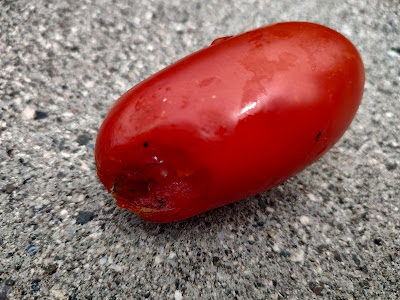
|
|
The damage on this tomato likely was the
work of a rodent -- probably a Norway rat.
(Photo: Debbie Arrington)
|
What’s eating my tomatoes? Often, it may be something you’d rather not think about – rats.
In my community garden this summer, we’ve been plagued by rats. They nested under a shed and grew fat on the nearby compost pile. Now, they’ve branched out to attack plants in several plots, digging holes under shrubs and other large plants.
Their damage can look like snail or hornworm damage on tomatoes. They nibble big, often irregular holes. Rats can climb, too. They’ll scale a tomato cage to feast on fruit 2 or 3 feet off the ground.
Rats tend to be active at night, so you’ll see their damage before you ever see the actual offender.
How can you tell the difference between rat or snail bites? Look for telltale “calling cards”: rat poop or snail slime.
Two kinds of rats are most common in Sacramento and both are invasive species. Roof rats, as the name implies, like to scamper across phone lines and into fruit trees. Naturally athletic, a roof rat can eat the entire interior of an orange while it’s still hanging on the tree. They also like to eat the skin off a Meyer lemon (but they’ll leave the pulp attached to the stem).
Norway rats are bigger and tend to stay close to the ground. They burrow, digging holes under shrubs and buildings. They like to nest under wood piles or overgrown plants.

|
|
This is a Norway rat, bane of vegetable gardeners. (Photo
courtesy UCIPM)
|
How do you tell a young rat from a full-grown mouse? The rat has a large head and big feet in proportion to its body.
According to UC master gardeners, there are no truly effective rat repellents available in California. Chili powder can deter them for a little while, but then they’ll figure out a way to get around it. Toxic baits have drawbacks, too; other animals may eat it. Rat baits can kill cats and dogs. Or cats or birds may eat a poisoned rat and also die.
Snap traps are effective but require removing the critter once caught.
“Trapping is the safest and most effective method for controlling rats in and around homes, garages, and other structures,” says the UC pest notes. “Because snap traps can be used over and over, trapping is less costly than poison baits but more labor intensive.”
UC research found the best bait for snap traps: shelled nuts, dried fruit, bacon or dog kibble. Cheese or peanut butter can be used, but rats can remove those soft foods without triggering the trap.
Rats are smart. If they escape one snap trap, they’ll avoid others. The master gardeners suggest this trick. Bait the traps but don’t set their triggers. The rat(s) will find the food and get comfortable stealing the bait. They think it’s safe to eat that kibble. Once all the bait is gone, reload the traps with bait and set their triggers. When the rats go back for more nibbles, they’ll get a big surprise.
Place traps about 10 to 20 feet apart along walls or other natural boundaries at a right angle to the wall with the trigger side closest to the wall.
Exclusion is the best strategy to keep rats away; take away their hiding places and don’t let them back in. Norway rats like to hide under overgrown tomato vines, shrubs or other lush growth that reaches the ground. That allows them to hide the entrance to their burrow. By removing the bottom foot of foliage, they lose that camouflage.
Make sure there’s adequate space between plants, preferably 2 or 3 feet. That forces rats to run out in the open – which they don’t like to do – when searching for food. Once exposed, they become targets for birds of prey such as owls.
If you find a burrow entrance, you can attempt to flood their home. Put a hose down the hole and let it run. The critters may try to escape via another entrance (which you’ll soon discover) or drown. Then, cover the entrances with mounds of dirt.


